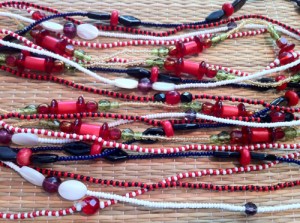
The standard set of necklaces received in the Eleke Initiation: Eleggua, Obatala, Oshun, Yemaya and Chango
One of the more select services we offer at the Santeria Church of the Orishas are Santeria Initiation. Initiation is a rite of passage that helps change a person’s destiny for the better. Initiation is not something automatically granted to all people. Initiation in Santeria must be designated through divination as something that is part of that person’s destiny otherwise it can cause problems for that person, ultimately disrupting their life and their fate. Think of initiation in Santeria as a prescription that should only be undertaken by those who have a need for it to heal their lives.
Initiation is an incremental process, and each initiation builds on the ones before it. Each initiation or ceremony that a person undertakes is one step toward a deeper relationship with the orishas and egun, as well as a deeper commitment to the religion of Santeria, one’s godparents and the greater Santeria community. Below we will describe the most typical initiations a person can experience in Santeria. We’ll elaborate if one initiation is a requirement for others, and we will explain which initiations we offer at the Santeria Church of the Orishas.
Please keep in mind that initiation creates a sacred bond and relationship between the initiate and their godparents. It is not something to be undertaken lightly and it is not something that we give out to just anyone at our church. There must be an established relationship before we’ll offer initiation to anyone.
How Do You Learn Santeria?
Traditionally, Santeria is not something you sit down in a class and learn. It is learned by actually practicing the religion side-by-side with an elder: your godparent. Santeria is learned through apprenticeship. Early on you may be asked to perform simple tasks like taking out trash, sweeping floors or washing basins, which may sound like they have nothing to do with Santeria, but in fact they do. Santeria is a communal religion. It is tribal at its core, and the entire tribe plays a part in every ceremony. You cannot really practice Santeria as a solitary person – the community is just as much a part of Santeria as are the orishas. By taking out trash and cleaning basins you learn that even the most simple of tasks is valuable and part of the health of the community. Sweeping becomes a sacred act of duty and sacrifice. Cooking becomes worship. Cracking open coconuts becomes an act of prayer. On a practical level you start to learn how things are done so that when help is needed you aren’t helpless. On a spiritual level you learn the art of working as a cohesive unit so that things get done faster. On a social level you are exposed to the stories and shared lore of others around you. Listening becomes one of the best ways of learning.
Once a person has received the first few initiations (elekes and warriors) they are privy to more information and start learning about the orishas. At this point they start learning more of the religious aspect of Santeria. With each initiation or orisha received, that person grows in their relationship with the orisha and their knowledge of our religion. Once a person has gone through kariocha and is an olorisha they are privy to the deepest levels of our religion’s lore, stories and ceremonies.
In each of these instances, the traditional and time-honored way to learn Santeria is under the guidance of an ethical and caring godparent. It is imperative for interested seekers to meet many olorishas and get to know them before dedicating themselves to being under their tutelage. We have heard too many stories of people with genuine faith and interest in Santeria ending up with unethical, fraudulent godparents or people who are abusive to their godkids. We recommend that you take your time and build a relationship with someone before receiving an initiation from them, for your connection will be for life thereafter, and not all godparents are willing or equipped to be good mentors for those who seek to learn. But without a godparent you cannot move forward in Santeria and you can’t really learn anything.
What do Santeria Initiations Involve?
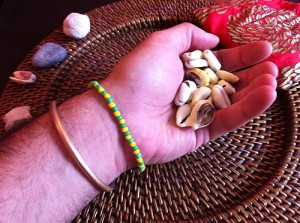
A diloggún reading (cowrie shell divination) is the best way to determine if initiation is part of your destiny.
Divination: Santeria initiations must be marked by divination first and foremost. This is our formal stance as a church, because divination is there to guide us and help us make the best informed decisions. If you are not marked to receive elekes through divination then you have no business receiving them. The same goes for any other initiation. Divination should be conducted with diloggún (cowrie shell divination) or through Ifá.
Derecho / Ashedí: Initiation in Santeria has an associated cost. This is called a derecho or “ashedÍ”. Some people have a deep distrust of any spiritual initiation or ceremony that costs money and this is a cultural variance from traditional African cultural values. Paying for an initiation is normal in African Traditional Religions like Santeria. The ashedí goes toward paying for items required for the initiation, vessels, tools, herbs, rental of a space (if necessary), animals, food to feed all those present), garments, cloth, supplies, as well as a stipend given to each godparent and the olorishas who come to work the ceremony. Ethical godparents should give a godchild a set amount for the ashedí, and that’s that. No plans should be made for the initiation until the ashedí is received by the godparent, and the ashedí amount should not change after it has been quoted unless an extraordinary amount of time has transpired since it was first quoted, or if items change price unexpectedly (as animals are prone to do). We encourage godparents to make a list of all the supplies needed for each initiation and give it to the prospective initiate to show them just how much these initiations cost. This will help alleviate any deceptive charging practices.
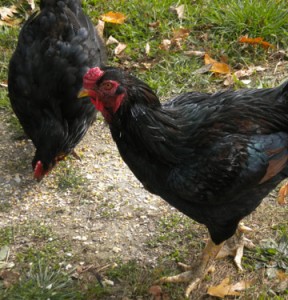
Animal sacrifice is a required part of every initiation in Santeria. Without blood sacrifice you do not have an orisha.
Animal Sacrifice: Every initiation in Santeria requires animal sacrifice. The reason why animal sacrifice must be present is because every initiation is a birth into a new life and destiny. The act of birth has blood associated with it. In order for the new orishas that are being birthed for the initiate to exist, they must consume the blood of sacrificed animals. If there is no animal sacrifice there is no real Santeria and no legitimate African Traditional Religion. Some people are trying to reinvent Santeria by eliminating animal sacrifice. This is non-legitimate practice and those initiations will never be accepted by any member of the African diasporic religions let alone Santeria. We feel that changing religious practice to eliminate animal sacrifice is an insult to our ancestors who fought and survived in the face of slavery to preserve their ritual observances. At the Santeria Church of the Orishas we recommend that the initiate witness the animal sacrifice so that they can appreciate the lives of the animals that are dying to save that person, to help them spiritually evolve, and so they appreciate where their food comes from. Usually the meat from sacrificed animals is shared with the community or is cooked for the next day’s activities to feed those present. If the animal was used to cleanse sickness or misfortune off of someone before it was sacrificed then its meat will not be eaten. Animal Sacrifice is a protected form of religious worship and is protected by the Supreme Court of the United States’ decision on the landmark court case Church of Lukumí Babalú Aye vs. The City of Hialeah.
Taboos and Restrictions: Many Santeria initiations entail a period of observed taboos or restrictions. These are placed on the new initiate to keep them energetically pure and to let the power of the initiation properly seat itself in the individual. These are small sacrifices a person makes in their life to create a greater sacred experience. The longest period of taboo and restriction is the year after a person undergoes kariocha. This is the year when the new initiate – an iyawó – must dress in white and observe strict behavioral restrictions. These can vary from ilé to ilé so we recommend you discuss any potential taboos or restrictions with your godparent before undergoing any initiation in Santeria.
Santeria Initiations Offered by Our Church
Elekes (also knowns as Collares or Necklaces): The first initiation most people experience in Santeria is the reception of the elekes. “Eleke” is the Lucumí word for beads, and the elekes are simple beaded necklaces in the patterns and colors of the 5 primary orishas of Santeria: Eleggua, Obatala, Oshun, Yemaya and Chango. You cannot just buy elekes in a store, put them on and think you have undergone this initiation. The ceremony of the elekes involves first consecrating the necklaces and empowering them through ritual washing, prayers, songs, and animal sacrifice. A beaded necklace that has not been ritually washed or fed is nothing more than jewelry. The elekes are the banners of the orishas and they serve to place that person under their protection. The ceremony of the elekes involves ritual bathing of the initiate and a koborí eledá (rogación de cabeza). The elekes are given to the person at the end of the ceremony. After this ceremony the initiate is considered an aborisha. Elekes should be worn at all times, but removed when bathing, swimming, sleeping, having sex, or when drinking alcohol or other substances.
Warriors (Guerreros) from Ocha: The second initiation most people experience in Santeria is the reception of the warriors from Ocha. The warriors are the first actual orishas a person typically receives. The warriors are Elegguá, Ogún, Ochosi and Osun. When a person receives the warriors, a new shrine for each of these orishas is consecrated in a sacred ceremony by their godparents and other olorishas participating in the ceremony. As part of the ceremony, the newly birthed orishas are fed in the act of animal sacrifice. The Warriors are born with no cowrie shells (diloggun) – they do not receive diloggun to complete them until later (Eleggua receives consecrated diloggun usually at kariocha, Ogún as a separate ceremony or as part of Pinaldo, Ochosi is completed with diloggún as part of a separate ceremony as well. Osun has no cowries.) Warriors received from an olorisha are the ones used in future initiations including kariocha. Warriors can be given by men or women. (There is a misconception that women cannot give warriors – this is incorrect. Please read our article about The Importance of Women in Santeria for more details.) The aborisha who receives the warriors now has the actual presence of orishas in his home and is responsible for attending to these shrines with offerings of cool water, rum, cigar, etc. Eleggua opens the aborisha’s spiritual path, Ogun clears the path of any obstacles, Ochosi helps the aborisha hit his intended goals, and Osun looks out for the aborisha’s well being, warning if there are any impending problems. Many godparents will instruct their godchildren to attend to their warrior shrines weekly on monday with an offering of cool water, rum and cigar, and by keeping Elegguá, Ogun and Ochosi lightly greased with palm oil. Usually Elekes are received prior to the Warriors initiation.
Olokun from Ocha: Olokun is a vastly powerful and deeply mysterious orisha. Often aborishas receive Olokun prior to kariocha but it is NOT required. The reception of Olokun is a type of addimú orisha – token orisha – given to a person to lend him depth to his spirituality and a stronger connection with his ancestors. Olokun also proves to be a boon for people’s prosperity and can give one the financial stability necessary to save money for kariocha. Olokun can be given by any olorisha who already has Olokun’s mysteries. Before receiving Olokun, an aborisha should have Eleggua (preferably the warriors), as Eleggua is the first orisha in all things. Olokun is born with cowries (diloggún) but they do not “speak” (aren’t used in divination).
Ibeji (the twins): Occasionally people will need to receive the Ibeji – the divine twin orishas. The reception of Ibeji is a type of addimú orisha – token orisha – given to a person for contentment and to help fend of negative obstructions in the aborisha’s life. This is not a requirement for kariocha. A person should have Eleggua prior to receiving the Ibeji as he receives animal sacrifice as part of this ceremony. The Ibeji are born with cowries (diloggún) but they do not speak (aren’t used for divination).
Addimú Orisha: On rare occasions a person is required to receive a particular orisha in their lives. This orisha acts as a powerful force to protect them from osogbo (misfortunes). Receiving an orisha outside of the kariocha ceremony is called receiving an Addimú Orisha. Olokun and the Ibeji are addimú orishas. A person can also receive addimú orishas after their kariocha – especially if their life reading (itá) indicated the need for reception of particular orishas as ebó. Addimú orishas are usually born with cowries (diloggún). If the addimú orisha was fed a four legged animal in its sacrifice then the diloggún can speak. If they have only been fed feathered animals then the diloggun cannot speak. Typical addimú orishas include Obatala, Inle, Ideú, Oyá, Obba and others.
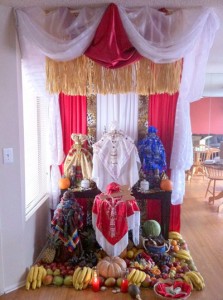
On the anniversary of an olorisha’s kariocha, a throne of cloth is built to commemorate the week he spent under his throne for his initiation. This is a throne to honor Rev. Dr. E.’s (Ekun Dayo Oní Shangó) initiation as a priest of Changó.
Kariocha (Ocha, Asiento, Hacer el Santo, Make Ocha, Ordination): Arguably the most powerful initiation in Santeria is kariocha (sometimes called Ocha, Hacer el Santo or “Making the Saint”). Kariocha means “to seat the orisha“, and in this ceremony a person’s tutelary orisha is seated on their head; they are literally crowned with that orisha. The ceremony of kariocha is marked through divination as a requirement for a person’s destiny, and is not something done “because you want to” or “because you love the orishas“. Simply put it is not for everyone to be crowned with the orisha. The kariocha is a huge ceremony that takes place over seven days and requires the involvement of many priests and priestesses. Prior to the kariocha a person’s tutelary orisha must be determined either through a bajada (a reading done by an olorisha using either Eleggua’s diloggún or the diloggún of the person’s godparent’s crowning orisha) or by three Babalawos using ikin and the opón ifá (table of Ifá). There is no other appropriate way to divine a person’s tutelary orisha and it should not be done until the person is already making preparations to be initiated, since their orisha can change up to the last moment.
In the Kariocha, the initiate spiritually dies and is reborn to a new life and a new destiny. He is given his tutelary orisha along with the orishas Eleggua (full with his diloggun), Obatala, Oshún, Yemaya and Changó. There are some minor variations but every Olorisha will receive these five orishas for sure, complete with their diloggún. The initiate will receive a life reading called an “itá” that contains all of the messages of their orishas guiding them to make the most of this new destiny. The new initiate is called an iyawó and will observe a year dressed entirely in white with strict behavioral restrictions including not being out at night, taking things from other peoples’ hands and not cutting their hair. This year, called an iyaworaje, is the most restrictive year of behavior in the religion and is the ultimate sacrifice made in service to the orishas. Many people feel that the way an iyawó behaves in his year will dictate how his entire life will play out. Three months after kariocha the iyawo is expected to undergo his Ebó Meta – three month ebó. At the three month ebó the orishas he received are awakened allowing the iyawo to then begin working with his orishas and giving them offerings. Once the year in white is done the iyawo is then an olorisha. Once that olorisha has been presented to our sacred room (the Igbodú) in which all initiations take place, he will then be able to help with initiations and give them to other people. He will become a fully functioning priest in Santeria.
Pinaldo (Pinadú, Cuchillo, The Knife): This ceremony is performed after a person has been made a priest or priestess through kariocha. In this ceremony the person’s orishas are all fed four-legged animal sacrifice once again, and the person’s Ogun is made full giving him diloggún. Men or women can receive Pinaldo. Pinaldo confers the right of that Olorisha to use the knife when sacrificing animals, and also acts as a completion and confirmation of that person’s kariocha.
Other Santeria Initiations
While we do not offer the following initiations at the Santeria Church of the Orishas, they are parts of traditional Santeria religious practice.
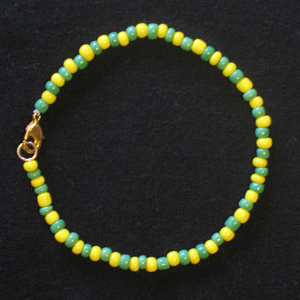
The Idé of Orunmila is usually received when a person received the initiation of Awofakán or Ikofá from a babalawo.
Awofakán / Ikofá (Mano de Orunla, Hand of Orunla): This initiation confers the secrets of Orunmila to those who are not of his priesthood. Orunmila’s sacred shrine is received along with a life reading (itá) from Orunla. This ceremony can only be performed by Babalawos and Oluwos. Men receive Awofakán and women receive Ikofá. If the person hasn’t already received the idé of Orunmila (bracelet of Orunmila) they will be given it along with an eleke (beaded necklace) of Orunmila when they receive Awofakán / Ikofá.
Warriors of Ifá: Babalawos also give warriors and they are exclusively used in Ifá ceremonies. Olorishas cannot utilize the warriors of Ifá in their ceremonies and at no time should the Eshu from Ifá received in these warriors go to the head of a new iyawó in the kariocha ceremony. Warriors from Ocha are used for Kariocha.
There are many other initiations in Santeria but these cover the major ones most people will encounter. If you are interested in pursuing a path toward initiation the best place to start is by receiving a diloggun reading and listening to the advice given in that reading. Rev. Dr. E. offers diloggún readings on his website ConjureDoctor.com if you are interested. For any other questions regarding initiation, contact us.

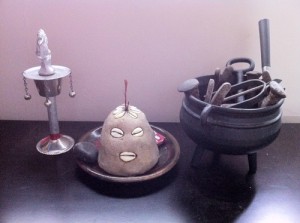
 Pagan Blog Project
Pagan Blog Project
Follow Us!